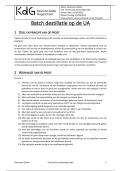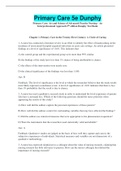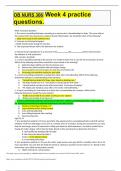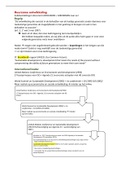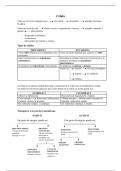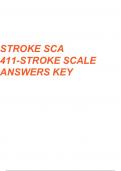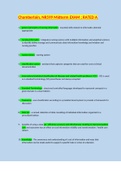Samenvatting
MANAGEMENT
Prof B. Vanlooy
Kaat De Muynck
MIM 2020-2021
KULEUVEN
1
,Inhoud
1: Introduction to Management and Organizations .......................................................................................... 5
L E A R N I N G O U T L I N E ........................................................................................................................... 5
1.1 Who Are Managers? ................................................................................................................................. 6
1.2 What Is Management? ............................................................................................................................. 6
1.3 What Do Managers Do? ........................................................................................................................... 7
1.3.1 Functional Approach ......................................................................................................................... 7
1.3.2 Management Roles Approach (Mintzberg) ....................................................................................... 7
1.3.3 Skills Approach .................................................................................................................................. 8
1.4 How The Manager’s Job Is Changing ........................................................................................................ 9
1.5 What is an organization? ........................................................................................................................11
1.6 Why Study Management? ......................................................................................................................11
1.7 Terms to Know........................................................................................................................................12
2: Management Yesterday and Today .............................................................................................................13
L E A R N I N G O U T L I N E .........................................................................................................................13
2.1 Historical Background of Management..................................................................................................14
2.2 Scientific Management...........................................................................................................................15
2.3 Scientific Management...........................................................................................................................16
2.4 General Administrative Theory ..............................................................................................................16
2.5 Quantitative Approach to Management ................................................................................................17
2.6 Understanding Organizational Behavior ................................................................................................17
2.6.1 The Hawthorne Studies ...................................................................................................................18
2.7 The Systems Approach ...........................................................................................................................19
2.8 The Contingency Approach ....................................................................................................................20
2.9 Current Trends and Issues ......................................................................................................................20
2. 9.1 Globalization ...................................................................................................................................21
2.9.3 Ethics ...............................................................................................................................................21
2.9.4 Workforce Diversity .........................................................................................................................21
2.9.5 Entrepreneurship Defined ...............................................................................................................21
2.9.6 Entrepreneurship process ...............................................................................................................22
2.9.7 E-Business (Electronic Business)......................................................................................................22
2.9.8 Categories of E-Businesses ..............................................................................................................22
2.9.9 Learning Organization .....................................................................................................................22
2.9.10 Knowledge Management ..............................................................................................................22
2.9.11 Quality Management.....................................................................................................................23
2.10 Terms to Know .....................................................................................................................................23
2
,3 Services Management: An Integrated Approach ..........................................................................................24
3.1 The Nature of Services ...........................................................................................................................24
3.1.1 Implications (examples)...................................................................................................................24
3.2 Linking HR Practices to Value Creation: A Case Study ............................................................................25
3.3 From HR Management principles towards HR Investment Principles (Miles & Creed)? .................28
4. Motivating Employees ..................................................................................................................................29
L E A R N I N G O U T L I N E .........................................................................................................................29
4.1 Wat is motivatie?....................................................................................................................................30
4.2 Vroege motivatietheorieën ....................................................................................................................30
4.2.1 Maslow's Hierarchy of Needs Theory ..............................................................................................30
4.2.2 McGregors Theory X en Theory Y ....................................................................................................31
4.2.3 Herzbergs motivatie-hygiënetheorie ..............................................................................................31
4.3 Hedendaagse theorieën over motivatie.................................................................................................31
4.4 Current Isssues in Motivation.................................................................................................................37
4.5 Van theorie naar praktijk: richtlijnen voor het motiveren van medewerkers .......................................40
4.6 Terms To know ......................................................................................................................................40
5. Leiderschap...................................................................................................................................................41
L E A R N I N G O U T L I N E .........................................................................................................................41
5.1 Leiders en leiderschap ............................................................................................................................42
5.2 Early Leadership Theories.......................................................................................................................42
5.3 Management Grid ..................................................................................................................................44
3.4 .................................................................................................................................................................44
5.4 Contingency Theories of Leadership ......................................................................................................45
5.4.1 The Fiedler-Model ...........................................................................................................................45
5.4.2 Hersey and Blanchard’s situational Leadership Theory ..................................................................46
5.4.3 Leader Participation Model .............................................................................................................46
5.4.5 Time Driven Model ..........................................................................................................................47
5.5.5 Path Goal Model ..............................................................................................................................47
5.5 Hedendaagse visies leiderschap .............................................................................................................48
5.6 Leiderschapsproblemen in de 21e eeuw ................................................................................................49
5.7 Cross-cultureel en gender leiderschap ...................................................................................................50
5.8 Terms to know ........................................................................................................................................51
6. Besluitvorming: de essentie van het werk van de manager ........................................................................52
L E A R N I N G E N G O U T L I N E................................................................................................................52
6.1 Decision Making .....................................................................................................................................53
6.2 Beslissingen maken ................................................................................................................................55
3
, 6.3 Soorten problemen en beslissingen .......................................................................................................56
6.3.1 Soorten geprogrammeerde beslissingen ........................................................................................57
6.3.2 Ongestructureerde problemen .......................................................................................................57
6.4 Besluitvormingsvoorwaarden ................................................................................................................58
6.5 Besluitvormingsstijlen ............................................................................................................................58
6.6 Decision Making: Eroors & Biases ..........................................................................................................59
6.7 Besluitvorming voor de wereld van vandaag .........................................................................................60
6.8 Terms to know ........................................................................................................................................61
7. Organizational Structure and Design............................................................................................................62
L E A R N I N G O U T L I N E ........................................................................................................................62
7.1 Organisatiestructuur definiëren .............................................................................................................63
7.2 Departmentaliztion by type ...................................................................................................................63
7.3 Organisatorische structuur .....................................................................................................................66
7.4 Organizational Design Decisions ............................................................................................................68
7.4.1 Mechanistische organisatie .............................................................................................................68
7.4.2 Organische organisatie ....................................................................................................................68
7.5 Contingency Factors ...............................................................................................................................68
7.5.1 Strategiekaders:...............................................................................................................................69
7.6 Common organizational designs ............................................................................................................70
7.7 De huidige uitdagingen op het gebied van organisatorisch ontwerp ....................................................72
4
MANAGEMENT
Prof B. Vanlooy
Kaat De Muynck
MIM 2020-2021
KULEUVEN
1
,Inhoud
1: Introduction to Management and Organizations .......................................................................................... 5
L E A R N I N G O U T L I N E ........................................................................................................................... 5
1.1 Who Are Managers? ................................................................................................................................. 6
1.2 What Is Management? ............................................................................................................................. 6
1.3 What Do Managers Do? ........................................................................................................................... 7
1.3.1 Functional Approach ......................................................................................................................... 7
1.3.2 Management Roles Approach (Mintzberg) ....................................................................................... 7
1.3.3 Skills Approach .................................................................................................................................. 8
1.4 How The Manager’s Job Is Changing ........................................................................................................ 9
1.5 What is an organization? ........................................................................................................................11
1.6 Why Study Management? ......................................................................................................................11
1.7 Terms to Know........................................................................................................................................12
2: Management Yesterday and Today .............................................................................................................13
L E A R N I N G O U T L I N E .........................................................................................................................13
2.1 Historical Background of Management..................................................................................................14
2.2 Scientific Management...........................................................................................................................15
2.3 Scientific Management...........................................................................................................................16
2.4 General Administrative Theory ..............................................................................................................16
2.5 Quantitative Approach to Management ................................................................................................17
2.6 Understanding Organizational Behavior ................................................................................................17
2.6.1 The Hawthorne Studies ...................................................................................................................18
2.7 The Systems Approach ...........................................................................................................................19
2.8 The Contingency Approach ....................................................................................................................20
2.9 Current Trends and Issues ......................................................................................................................20
2. 9.1 Globalization ...................................................................................................................................21
2.9.3 Ethics ...............................................................................................................................................21
2.9.4 Workforce Diversity .........................................................................................................................21
2.9.5 Entrepreneurship Defined ...............................................................................................................21
2.9.6 Entrepreneurship process ...............................................................................................................22
2.9.7 E-Business (Electronic Business)......................................................................................................22
2.9.8 Categories of E-Businesses ..............................................................................................................22
2.9.9 Learning Organization .....................................................................................................................22
2.9.10 Knowledge Management ..............................................................................................................22
2.9.11 Quality Management.....................................................................................................................23
2.10 Terms to Know .....................................................................................................................................23
2
,3 Services Management: An Integrated Approach ..........................................................................................24
3.1 The Nature of Services ...........................................................................................................................24
3.1.1 Implications (examples)...................................................................................................................24
3.2 Linking HR Practices to Value Creation: A Case Study ............................................................................25
3.3 From HR Management principles towards HR Investment Principles (Miles & Creed)? .................28
4. Motivating Employees ..................................................................................................................................29
L E A R N I N G O U T L I N E .........................................................................................................................29
4.1 Wat is motivatie?....................................................................................................................................30
4.2 Vroege motivatietheorieën ....................................................................................................................30
4.2.1 Maslow's Hierarchy of Needs Theory ..............................................................................................30
4.2.2 McGregors Theory X en Theory Y ....................................................................................................31
4.2.3 Herzbergs motivatie-hygiënetheorie ..............................................................................................31
4.3 Hedendaagse theorieën over motivatie.................................................................................................31
4.4 Current Isssues in Motivation.................................................................................................................37
4.5 Van theorie naar praktijk: richtlijnen voor het motiveren van medewerkers .......................................40
4.6 Terms To know ......................................................................................................................................40
5. Leiderschap...................................................................................................................................................41
L E A R N I N G O U T L I N E .........................................................................................................................41
5.1 Leiders en leiderschap ............................................................................................................................42
5.2 Early Leadership Theories.......................................................................................................................42
5.3 Management Grid ..................................................................................................................................44
3.4 .................................................................................................................................................................44
5.4 Contingency Theories of Leadership ......................................................................................................45
5.4.1 The Fiedler-Model ...........................................................................................................................45
5.4.2 Hersey and Blanchard’s situational Leadership Theory ..................................................................46
5.4.3 Leader Participation Model .............................................................................................................46
5.4.5 Time Driven Model ..........................................................................................................................47
5.5.5 Path Goal Model ..............................................................................................................................47
5.5 Hedendaagse visies leiderschap .............................................................................................................48
5.6 Leiderschapsproblemen in de 21e eeuw ................................................................................................49
5.7 Cross-cultureel en gender leiderschap ...................................................................................................50
5.8 Terms to know ........................................................................................................................................51
6. Besluitvorming: de essentie van het werk van de manager ........................................................................52
L E A R N I N G E N G O U T L I N E................................................................................................................52
6.1 Decision Making .....................................................................................................................................53
6.2 Beslissingen maken ................................................................................................................................55
3
, 6.3 Soorten problemen en beslissingen .......................................................................................................56
6.3.1 Soorten geprogrammeerde beslissingen ........................................................................................57
6.3.2 Ongestructureerde problemen .......................................................................................................57
6.4 Besluitvormingsvoorwaarden ................................................................................................................58
6.5 Besluitvormingsstijlen ............................................................................................................................58
6.6 Decision Making: Eroors & Biases ..........................................................................................................59
6.7 Besluitvorming voor de wereld van vandaag .........................................................................................60
6.8 Terms to know ........................................................................................................................................61
7. Organizational Structure and Design............................................................................................................62
L E A R N I N G O U T L I N E ........................................................................................................................62
7.1 Organisatiestructuur definiëren .............................................................................................................63
7.2 Departmentaliztion by type ...................................................................................................................63
7.3 Organisatorische structuur .....................................................................................................................66
7.4 Organizational Design Decisions ............................................................................................................68
7.4.1 Mechanistische organisatie .............................................................................................................68
7.4.2 Organische organisatie ....................................................................................................................68
7.5 Contingency Factors ...............................................................................................................................68
7.5.1 Strategiekaders:...............................................................................................................................69
7.6 Common organizational designs ............................................................................................................70
7.7 De huidige uitdagingen op het gebied van organisatorisch ontwerp ....................................................72
4

